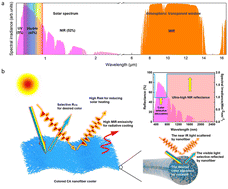Selective spectral absorption of nanofibers for color-preserving daytime radiative cooling†
Abstract
Passive radiative cooling is a promising solution for cooling objects without consuming energy. However, chemical colors absorb visible light and generate heat, posing a challenge in the design of a colored sub-ambient daytime radiative cooler (CSDRC) in a simple and scalable way. Herein, we used nanofibers (NF) to achieve selective spectral absorption of the daytime radiative cooler through a dope-dyeing electrospinning technique. This approach allows for the selective absorption of desired colors in the visible spectrum, while the nanofiber structure provides strong visible and near-infrared light scattering to minimize solar heating. We selected cellulose acetate (CA) with mid-infrared emittance characteristics for efficient sky cooling. Our design enabled the CA NF CSDRC to exhibit an ultra-high NIR reflectance of 99%, a high MIR emittance of 95%, and vibrant colors. These unique optical properties resulted in a reduction of the maximum ambient temperature by 3.2 °C and a cooling power of ≈40 W m−2 at a solar intensity of 700 W m−2. Additionally, the flexibility and deformability of the colored nanofiber cooler make it suitable for thermal management in various practical applications. Our work provides a simple and scalable solution for designing colored passive radiative cooling materials.

- This article is part of the themed collections: Most popular articles from National University of Singapore and New horizons in materials for energy conversion, optics and electronics


 Please wait while we load your content...
Please wait while we load your content...